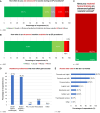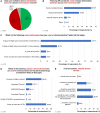Vascular access site management during electrophysiology procedures: a European Heart Rhythm Association survey
- PMID: 40522938
- PMCID: PMC12212052
- DOI: 10.1093/europace/euaf117
Vascular access site management during electrophysiology procedures: a European Heart Rhythm Association survey
Abstract
Aims: Reliable vascular access and haemostasis techniques are important to the safety of electrophysiology (EP) procedures. This European Heart Rhythm Association (EHRA) survey aimed to evaluate contemporary vascular access site management practices across international EP centres.
Methods and results: A 30-question survey was disseminated via the EHRA between March and April 2025, with 401 responses from professionals across 51 countries. Most respondents were cardiology consultants/attendings (82.0%), with 57.3% performing over 150 EP procedures annually. Ultrasound guidance for vascular access was usually or always used by 71.7%, though 21.4% used it rarely or never, and only 17.3% had received formal ultrasound training. Institutional protocols for haemostasis were lacking in around half (46.8%) of centres. Suture-mediated closure was the most common method for haemostasis (60.4%), followed by manual compression (33.0%) and vascular closure devices (VCDs, 5.8%). The figure-of-eight suture with a hand-tied knot was the most frequently used suture technique (79.7%). Just over a third (36.0%) had experience with VCDs, typically reserved for high-risk cases. For procedures requiring transeptal access, 38.1% administered heparin before transeptal puncture, while protamine was rarely or never used by 62.1%. Anticoagulation was partially interrupted in 52.1% and continued uninterrupted in 41.1% of routine atrial fibrillation (AF) ablations. The median bed rest duration post-procedure ranged from 4 h (right-sided EP procedures) to 6 h (AF or left-sided EP procedures). The average quoted vascular complication risk during consent was 3% (inter-quartile range 1-5%).
Conclusion: This survey highlights marked variation in vascular access site management during and following EP procedures, emphasizing the need for further clinical trials to inform best practice and guide future standardization efforts.
Keywords: Catheter ablation; Complications; Electrophysiology; Haemostasis; Vascular access.
© The Author(s) 2025. Published by Oxford University Press on behalf of the European Society of Cardiology.
Conflict of interest statement
Conflict of interest: D.G. has received institutional research grants from Boston Scientific and Medtronic and speaker fees from Boston Scientific. V.L. has received institutional research grants from J&J MedTech and speaker fees for Boston Scientific and J&J MedTech. M.M.Z. has received lecture fees/honoraria and travel support by Medtronic, Boston Scientific, Bayer Vital, Pfizer, Abbott, ZOLL CMS, and AstraZeneca. P.F. holds patents related to high-voltage and bipolar ablation and equity in CorSystem. C.-H.H. has received travel grants and research grants from Boston Scientific, LifTech, Biosense Webster, and Haemonetics and speaker honoraria from Boston Scientific, Biosense Webster, Pfizer, Haemonetics, BMS, and C.T.I. GmbH and Doctrina Med. A.M. is a consultant for and has received honoraria from Abbott, Medtronic, Boston Scientific, and Biosense Webster. J.K.R.C. is a consultant for and has received honoraria/research funding from Abbott, Medtronic, Boston Scientific, and Biosense Webster. The other authors report no conflicts of interest. No funding was received towards this work.
Figures






Similar articles
-
Vascular closure devices for femoral arterial puncture site haemostasis.Cochrane Database Syst Rev. 2016 Mar 7;3(3):CD009541. doi: 10.1002/14651858.CD009541.pub2. Cochrane Database Syst Rev. 2016. PMID: 26948236 Free PMC article.
-
Interrupted versus uninterrupted anticoagulation therapy for catheter ablation in adults with arrhythmias.Cochrane Database Syst Rev. 2021 Oct 21;10(10):CD013504. doi: 10.1002/14651858.CD013504.pub2. Cochrane Database Syst Rev. 2021. PMID: 34674223 Free PMC article.
-
Curative catheter ablation in atrial fibrillation and typical atrial flutter: systematic review and economic evaluation.Health Technol Assess. 2008 Nov;12(34):iii-iv, xi-xiii, 1-198. doi: 10.3310/hta12340. Health Technol Assess. 2008. PMID: 19036232
-
Cerebral Protection Devices in Case of Left Sided Intracardiac Thrombus: A Multicentre Experience From the Cath Lab and EP Lab.Catheter Cardiovasc Interv. 2025 May;105(6):1516-1522. doi: 10.1002/ccd.31487. Epub 2025 Mar 12. Catheter Cardiovasc Interv. 2025. PMID: 40071304
-
A systematic review of vascular closure devices for femoral artery puncture sites.J Vasc Surg. 2018 Sep;68(3):887-899. doi: 10.1016/j.jvs.2018.05.019. Epub 2018 Jun 29. J Vasc Surg. 2018. PMID: 30146036
References
-
- Scheinman MM. The first ablation. Heart Rhythm 2024;21:519–20. - PubMed
-
- Benali K, Khairy P, Hammache N, Petzl A, Da Costa A, Verma A et al. Procedure-related complications of catheter ablation for atrial fibrillation. J Am Coll Cardiol 2023;81:2089–99. - PubMed
-
- Bohnen M, Stevenson WG, Tedrow UB, Michaud GF, John RM, Epstein LM et al. Incidence and predictors of major complications from contemporary catheter ablation to treat cardiac arrhythmias. Heart Rhythm 2011;8:1661–6. - PubMed
-
- Ding WY, Khanra D, Kozhuharov N, Shaw M, Luther V, Ashrafi R et al. Incidence of vascular complications for electrophysiology procedures in the ultrasound era: a single-centre experience over 10,000 procedures in the long term. J Interv Card Electrophysiol 2023;66:693–700. - PubMed
MeSH terms
LinkOut - more resources
Full Text Sources
Miscellaneous

